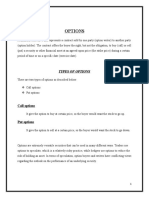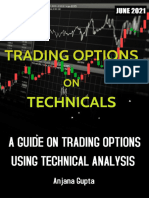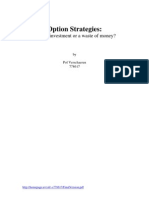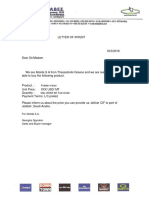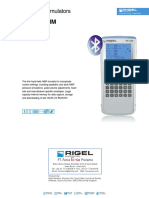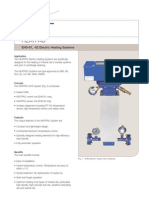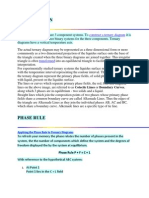11 - U102088 - Futops Faqs
11 - U102088 - Futops Faqs
Uploaded by
Sanjeev MohapatraCopyright:
Available Formats
11 - U102088 - Futops Faqs
11 - U102088 - Futops Faqs
Uploaded by
Sanjeev MohapatraOriginal Description:
Original Title
Copyright
Available Formats
Share this document
Did you find this document useful?
Is this content inappropriate?
Copyright:
Available Formats
11 - U102088 - Futops Faqs
11 - U102088 - Futops Faqs
Uploaded by
Sanjeev MohapatraCopyright:
Available Formats
FAQs: Futures and Options
For investors who have difficulty in understanding the terminologies associated with options and futures as well as its modes of working, here's some lucid explanation. What are options? An option is a contract, which gives the buyer (holder) the right, but not the obligation, to buy or sell specified quantity of the underlying assets, at a specific (strike) price on or before a specified time (expiration date). The underlying may be commodities like wheat/ rice/ cotton/ gold/ oil or financial instruments like equity stocks/ stock index/ bonds etc. Important Terminology Underlying - The specific security / asset on which an options contract is based. Option Premium - This is the price paid by the buyer to the seller to acquire the right to buy or sell Strike Price or Exercise Price - The strike or exercise price of an option is the specified/ predetermined price of the underlying asset at which the same can be bought or sold if the option buyer exercises his right to buy/ sell on or before the expiration day. Expiration date - The date on which the option expires is known as Expiration Date. On Expiration date, either the option is exercised or it expires worthless. Exercise Date - is the date on which the option is actually exercised. In case of European Options the exercise date is same as the expiration date while in case of American Options, the options contract may be exercised any day between the purchase of the contract and its expiration date (see European/ American Option) Open Interest - The total number of options contracts outstanding in the market at any given point of time. Option Holder: is the one who buys an option which can be a call or a put option. He enjoys the right to buy or sell the underlying asset at a specified price on or before specified time. His upside potential is unlimited while losses are limited to the Premium paid by him to the option writer. Option seller/ writer: is the one who is obligated to buy (in case of Put option) or to sell (in case of call option), the underlying asset in case the buyer of the option decides to exercise his option. His profits are limited to the premium received from the buyer while his downside is unlimited. Option Class: All listed options of a particular type (i.e., call or put) on a particular underlying instrument, e.g., all Sensex Call Options (or) all Sensex Put Options Option Series: An option series consists of all the options of a given class with the same expiration date and strike price. E.g. BSXCMAY3600 is an options series which includes all Sensex Call options that are traded with Strike Price of 3600 & Expiry in May. (BSX Stands for BSE Sensex (underlying index), C is for Call Option , May is expiry date and strike Price is 3600) What is Assignment? When the holder of an option exercises his right to buy/ sell, a randomly selected option seller is assigned the obligation to honor the underlying contract, and this process is termed as Assignment.
What are European and American Style of options? An American style option is the one which can be exercised by the buyer on or before the expiration date, i.e. anytime between the day of purchase of the option and the day of its expiry. The European kind of option is the one which can be exercised by the buyer on the expiration day only & not anytime before that. What are Call Options? A call option gives the holder (buyer/ one who is long call), the right to buy specified quantity of the underlying asset at the strike price on or before expiration date. The seller (one who is short call) however, has the obligation to sell the underlying asset if the buyer of the call option decides to exercise his option to buy. Example: An investor buys One European call option on Infosys at the strike price of Rs. 3500 at a premium of Rs. 100. If the market price of Infosys on the day of expiry is more than Rs. 3500, the option will be exercised. The investor will earn profits once the share price crosses Rs. 3600 (Strike Price + Premium i.e. 3500+100). Suppose stock price is Rs. 3800, the option will be exercised and the investor will buy 1 share of Infosys from the seller of the option at Rs 3500 and sell it in the market at Rs 3800 making a profit of Rs. 200 { (Spot price - Strike price) - Premium}. In another scenario, if at the time of expiry stock price falls below Rs. 3500 say suppose it touches Rs. 3000, the buyer of the call option will choose not to exercise his option. In this case the investor loses the premium (Rs 100), paid which shall be the profit earned by the seller of the call option. What are Put Options? A Put option gives the holder (buyer/ one who is long Put), the right to sell specified quantity of the underlying asset at the strike price on or before a expiry date. The seller of the put option (one who is short Put) however, has the obligation to buy the underlying asset at the strike price if the buyer decides to exercise his option to sell. Example: An investor buys one European Put option on Reliance at the strike price of Rs. 300/-, at a premium of Rs. 25/-. If the market price of Reliance, on the day of expiry is less than Rs. 300, the option can be exercised as it is 'in the money'. The investor's Break even point is Rs. 275/ (Strike Price - premium paid) i.e., investor will earn profits if the market falls below 275. Suppose stock price is Rs. 260, the buyer of the Put option immediately buys Reliance share in the market @ Rs. 260/- & exercises his option selling the Reliance share at Rs 300 to the option writer thus making a net profit of Rs. 15 {(Strike price - Spot Price) - Premium paid}. In another scenario, if at the time of expiry, market price of Reliance is Rs 320/ - , the buyer of the Put option will choose not to exercise his option to sell as he can sell in the market at a higher rate. In this case the investor loses the premium paid (i.e Rs 25/-), which shall be the profit earned by the seller of the Put option. (Please see table)
How are options different from futures? The significant differences in Futures and Options are as under: Futures are agreements/contracts to buy or sell specified quantity of the underlying assets at a price agreed upon by the buyer and seller, on or before a specified time. Both the buyer and seller are obligated to buy/sell the underlying asset. In case of options the buyer enjoys the right and not the obligation, to buy or sell the underlying asset. Futures Contracts have symmetric risk profile for both buyers as well as sellers, whereas options have asymmetric risk profile. In case of Options, for a buyer (or holder of the option), the downside is limited to the premium (option price) he has paid while the profits may be unlimited. For a seller or writer of an option, however, the downside is unlimited while profits are limited to the premium he has received from the buyer. The futures contracts prices are affected mainly by the prices of the underlying asset. Prices of options are however, affected by prices of the underlying asset, time remaining for expiry of the contract and volatility of the underlying asset. It costs nothing to enter into a futures contract whereas there is a cost of entering into an options contract, termed as Premium. Explain In the Money, At the Money and Out of the money Options. An option is said to be 'at-the-money', when the option's strike price is equal to the underlying asset price. This is true for both puts and calls. A call option is said to be in-the-money when the strike price of the option is less than the underlying asset price. For example, a Sensex call option with strike of 3900 is 'in-the-money', when the spot Sensex is at 4100 as the call option has value. The call holder has the right to buy a Sensex at 3900, no matter how much the spot market price has risen. And with the current price at 4100, a profit can be made by selling Sensex at this higher price. On the other hand, a call option is out-of-the-money when the strike price is greater than the underlying asset price. Using the earlier example of Sensex call option, if the Sensex falls to 3700, the call option no longer has positive exercise value. The call holder will not exercise the option to buy Sensex at 3900 when the current price is at 3700. (Please see table) A put option is in-the-money when the strike price of the option is greater than the spot price of the underlying asset. For example, a Sensex put at strike of 4400 is in-the-money when the Sensex is at 4100. When this is the case, the put option has value because the put holder can sell the Sensex at 4400, an amount greater than the current Sensex of 4100. Likewise, a put option is out-of-the-money when the strike price is less than the spot price of underlying asset. In the above example, the buyer of Sensex put option won't exercise the option when the spot is at 4800. The put no longer has positive exercise value. Options are said to be deep in-the-money (or deep out-of-the-money) if the exercise price is at
significant variance with the underlying asset price. What are Covered and Naked Calls? A call option position that is covered by an opposite position in the underlying instrument (for example shares, commodities etc), is called a covered call. Writing covered calls involves writing call options when the shares that might have to be delivered (if option holder exercises his right to buy), are already owned. E.g. A writer writes a call on Reliance and at the same time holds shares of Reliance so that if the call is exercised by the buyer, he can deliver the stock. Covered calls are far less risky than naked calls (where there is no opposite position in the underlying), since the worst that can happen is that the investor is required to sell shares already owned at below their market value. When a physical delivery uncovered/ naked call is assigned an exercise, the writer will have to purchase the underlying asset to meet his call obligation and his loss will be the excess of the purchase price over the exercise price of the call reduced by the premium received for writing the call. What is the Intrinsic Value of an option? The intrinsic value of an option is defined as the amount by which an option is in-the-money, or the immediate exercise value of the option when the underlying position is marked-to-market. For a call option: Intrinsic Value = Spot Price - Strike Price For a put option: Intrinsic Value = Strike Price - Spot Price The intrinsic value of an option must be a positive number or 0. It cannot be negative. For a call option, the strike price must be less than the price of the underlying asset for the call to have an intrinsic value greater than 0. For a put option, the strike price must be greater than the underlying asset price for it to have intrinsic value. Explain Time Value with reference to Options. Time value is the amount option buyers are willing to pay for the possibility that the option may become profitable prior to expiration due to favorable change in the price of the underlying. An option loses its time value as its expiration date nears. At expiration an option is worth only its intrinsic value. Time value cannot be negative. What are the factors that affect the value of an option (premium)? There are two types of factors that affect the value of the option premium: Quantifiable Factors: underlying stock price, the strike price of the option, the volatility of the underlying stock, the time to expiration and; the risk free interest rate. Non-Quantifiable Factors :
Market participants' varying estimates of the underlying asset's future volatility Individuals' varying estimates of future performance of the underlying asset, based on fundamental or technical analysis The effect of supply & demand- both in the options marketplace and in the market for the underlying asset The "depth" of the market for that option - the number of transactions and the contract's trading volume on any given day. What are different pricing models for options? The theoretical option pricing models are used by option traders for calculating the fair value of an option on the basis of the earlier mentioned influencing factors. An option pricing model assists the trader in keeping the prices of calls & puts in proper numerical relationship to each other & helping the trader make bids & offer quickly. The two most popular option pricing models are: Black Scholes Model which assumes that percentage change in the price of underlying follows a normal distribution. Binomial Model which assumes that percentage change in price of the underlying follows a binomial distribution. Who decides on the premium paid on options & how is it calculated? Options Premium is not fixed by the Exchange. The fair value/ theoretical price of an option can be known with the help of pricing models and then depending on market conditions the price is determined by competitive bids and offers in the trading environment. An option's premium / price is the sum of Intrinsic value and time value (explained above). If the price of the underlying stock is held constant, the intrinsic value portion of an option premium will remain constant as well. Therefore, any change in the price of the option will be entirely due to a change in the option's time value. The time value component of the option premium can change in response to a change in the volatility of the underlying, the time to expiry, interest rate fluctuations, dividend payments and to the immediate effect of supply and demand for both the underlying and its option. Explain the Option Greeks? The price of an Option depends on certain factors like price and volatility of the underlying, time to expiry etc. The option Greeks are the tools that measure the sensitivity of the option price to the above mentioned factors. They are often used by professional traders for trading and managing the risk of large positions in options and stocks. These Option Greeks are: Delta: is the option Greek that measures the estimated change in option premium/price for a change in the price of the underlying. Gamma: measures the estimated change in the Delta of an option for a change in the price of the underlying
Vega : measures estimated change in the option price for a change in the volatility of the underlying. Theta: measures the estimated change in the option price for a change in the time to option expiry. Rho: measures the estimated change in the option price for a change in the risk free interest rates. What is an Option Calculator? An option calculator is a tool to calculate the price of an Option on the basis of various influencing factors like the price of the underlying and its volatility, time to expiry, risk free interest rate etc. It also helps the user to understand how a change in any one of the factors or more, will affect the option price. Who are the likely players in the Options Market? Developmental institutions, Mutual Funds, FIs, FIIs, Brokers, Retail Participants are the likely players in the Options Market. Why do I invest in Options? What do options offer me? Besides offering flexibility to the buyer in form of right to buy or sell, the major advantage of options is their versatility. They can be as conservative or as speculative as one's investment strategy dictates. Some of the benefits of Options are as under: High leverage as by investing small amount of capital (in form of premium), one can take exposure in the underlying asset of much greater value. Pre-known maximum risk for an option buyer Large profit potential and limited risk for option buyer One can protect his equity portfolio from a decline in the market by way of buying a protective put wherein one buys puts against an existing stock position. This option position can supply the insurance needed to overcome the uncertainty of the marketplace. Hence, by paying a relatively small premium (compared to the market value of the stock), an investor knows that no matter how far the stock drops, it can be sold at the strike price of the Put anytime until the Put expires. E.g. An investor holding 1 share of Infosys at a market price of Rs 3800/-thinks that the stock is over-valued and decides to buy a Put option' at a strike price of Rs. 3800/- by paying a premium of Rs 200/If the market price of Infosys comes down to Rs 3000/-, he can still sell it at Rs 3800/- by exercising his put option. Thus, by paying premium of Rs 200,his position is insured in the underlying stock. How can I use options? If you anticipate a certain directional movement in the price of a stock, the right to buy or sell that stock at a predetermined price, for a specific duration of time can offer an attractive investment opportunity. The decision as to what type of option to buy is dependent on whether your outlook for the respective security is positive (bullish) or negative (bearish).
If your outlook is positive, buying a call option creates the opportunity to share in the upside potential of a stock without having to risk more than a fraction of its market value (premium paid). Conversely, if you anticipate downward movement, buying a put option will enable you to protect against downside risk without limiting profit potential. Purchasing options offer you the ability to position yourself accordingly with your market expectations in a manner such that you can both profit and protect with limited risk. Once I have bought an option and paid the premium for it, how does it get settled? Option is a contract which has a market value like any other tradable commodity. Once an option is bought there are following alternatives that an option holder has: You can sell an option of the same series as the one you had bought and close out /square off your position in that option at any time on or before the expiration. You can exercise the option on the expiration day in case of European Option or; on or before the expiration day in case of an American option. In case the option is 'Out of Money' at the time of expiry, it will expire worthless. What are the risks involved for an options buyer? The risk/ loss of an option buyer is limited to the premium that he has paid. What are the risks for an Option writer? The risk of an Options Writer is unlimited where his gains are limited to the Premiums earned. When a physical delivery uncovered call is exercised upon, the writer will have to purchase the underlying asset and his loss will be the excess of the purchase price over the exercise price of the call reduced by the premium received for writing the call. The writer of a put option bears a risk of loss if the value of the underlying asset declines below the exercise price. The writer of a put bears the risk of a decline in the price of the underlying asset potentially to zero. How can an option writer take care of his risk? Option writing is a specialized job which is suitable only for the knowledgeable investor who understands the risks, has the financial capacity and has sufficient liquid assets to meet applicable margin requirements. The risk of being an option writer may be reduced by the purchase of other options on the same underlying asset thereby assuming a spread position or by acquiring other types of hedging positions in the options/ futures and other correlated markets. Who can write options in Indian derivatives market? In the Indian Derivatives market, Sebi has not created any particular category of options writers. Any market participant can write options. However, margin requirements are stringent for options writers. What are Stock Index Options? The Stock Index Options are options where the underlying asset is a Stock Index for e.g. Options on S&P 500 Index/ Options on BSE Sensex etc. Index Options were first introduced by Chicago Board of Options Exchange in 1983 on its Index 'S&P 100'. As opposed to options on Individual stocks, index options give an investor the right to buy or sell the value of an index which represents group of stocks. What are the uses of Index Options? Index options enable investors to gain exposure to a broad market, with one trading decision and
frequently with one transaction. To obtain the same level of diversification using individual stocks or individual equity options, numerous decisions and trades would be necessary. Since, broad exposure can be gained with one trade, transaction cost is also reduced by using Index Options. As a percentage of the underlying value, premiums of index options are usually lower than those of equity options as equity options are more volatile than the Index. Who would use index options? Index Options are effective enough to appeal to a broad spectrum of users, from conservative investors to more aggressive stock market traders. Individual investors might wish to capitalize on market opinions (bullish, bearish or neutral) by acting on their views of the broad market or one of its many sectors. The more sophisticated market professionals might find the variety of index option contracts excellent tools for enhancing market timing decisions and adjusting asset mixes for asset allocation. To a market professional, managing risks associated with large equity positions may mean using index options to either reduce risk or increase market exposure. What are Options on individual stocks? Options contracts where the underlying asset is an equity stock, are termed as Options on stocks. They are mostly American style options cash settled or settled by physical delivery. Prices are normally quoted in terms of the premium per share, although each contract is invariably for a larger number of shares, e.g. 100. How will introduction of options in specific stocks benefit an investor? Options can offer an investor the flexibility one needs for countless investment situations. An investor can create hedging position or an entirely speculative one, through various strategies that reflect his tolerance for risk. Investors of equity stock options will enjoy more leverage than their counterparts who invest in the underlying stock market itself in form of greater exposure by paying a small amount as premium. Investors can also use options in specific stocks to hedge their holding positions in the underlying (i.e. long in the stock itself), by buying a Protective Put. Thus they will insure their portfolio of equity stocks by paying premium. ESOPs (Employees' stock options) have become a popular compensation tool with more and more companies offering the same to their employees. ESOPs are subject to lock in periods, which could reduce capital gains in falling markets - Derivatives can help arrest that loss along with tax savings. An ESOPs holder can buy Put Option in the underlying stock & exercise the same if the market falls below the strike price & lock in his sale prices Whether exchange traded equity options are issued by companies underlying them. The equity options traded on exchange are not issued by the companies underlying them. Companies do not have any say in selection of underlying equity for options. Whether the holders of equity options contracts have all the rights that the owners of equity shares have. Holder of the equity options contracts do not have any of the rights that owners of equity shares
have - such as voting rights and the right to receive bonus, dividend etc. To obtain these rights a Call option holder must exercise his contract and take delivery of the underlying equity shares. What are Leaps (long term equity anticipation securities)? Long term equity anticipation securities (Leaps) are long-dated put and call options on common stocks or ADRs. These long-term options provide the holder the right to purchase, in case of a call, or sell, in case of a put, a specified number of stock shares at a pre-determined price up to the expiration date of the option, which can be three years in the future. What are exotic Options? Derivatives with more complicated payoffs than the standard European or American calls and puts are referred to as Exotic Options. Some of the examples of exotic options are as under: Barrier Options: where the payoff depends on whether the underlying asset's price reaches a certain level during a certain period of time. CAPS traded on CBOE (traded on the S&P 100 & S&P 500) are examples of Barrier Options where the pay-out is capped so that it cannot exceed $30. A Call CAP is automatically exercised on a day when the index closes more than $30 above the strike price. A put CAP is automatically exercised on a day when the index closes more than $30 below the cap level. Binary Options: are options with discontinuous payoffs. A simple example would be an option which pays off if price of an Infosys share ends up above the strike price of say Rs. 4000 & pays off nothing if it ends up below the strike. What are Over-The-Counter Options? Over-The-Counter options are those dealt directly between counter-parties and are completely flexible and customized. There is some standardization for ease of trading in the busiest markets, but the precise details of each transaction are freely negotiable between buyer and seller. Where can I trade in Options and Futures contracts. Like stocks, options and futures contracts are also traded on any exchange. In Bombay Stock Exchange, stocks are traded on BSE On Line Trading (BOLT) system and options and futures are traded on Derivatives Trading and Settlement System (DTSS). What is the underlying in case of Options being introduced by BSE? The underlying for the index options is the BSE 30 Sensex, which is the benchmark index of Indian Capital markets, comprising 30 scrips. What are the contract specifications of Sensex Options? BSE's first index options is based on BSE 30 Sensex. The Sensex options would be European style of options i.e. the options would be exercised only on the day of expiry. They will be premium style i.e. the buyer of the option will pay premium to the options writer in cash at the time of entering into the contract. The Premium and Options Settlement Value (difference between Strike and Spot price at the time of expiry), will be quoted in Sensex points The contract multiplier for Sensex options is INR 50 which means that monetary value of the Premium and Settlement value will be calculated by multiplying the Sensex Points by 50. For e.g. if Premium quoted for a Sensex options is 50 Sensex points, its monetary value would be
Rs. 2500 (50*50). There will be at-least 5 strikes (2 In the Money, 1 Near the money, 2 Out of the money), available at any point of time. The expiration day for Sensex option is the last Thursday of Contract month. If it is a holiday, the immediately preceding business day will be the expiration day. There will be three contract month series (Near, middle and far) available for trading at any point of time. The settlement value will be the closing value of the Sensex on the expiry day. The tick size for Sensex option is 0.1 Sensex points (INR 5). This means the minimum price fluctuation in the value of the option premium can be 0.1.In Rupee terms this translates to minimum price fluctuation of Rs 5. ( Tick Size * Multiplier =0.1* 50). What is SPAN? Specific Portfolio Analysis of Risk (SPAN) is a worldwide acknowledged risk management system developed by Chicago Mercantile Exchange (CME). It is a portfolio-based margin calculating system adopted by all major Derivatives Exchanges. Objective of SPAN SPAN identifies overall risk in a complete portfolio of futures and options at the same time recognizing the unique exposures associated with both inter-month and inter-commodity risk relationships. It determines the largest loss that a portfolio might suffer with in the period specified by the exchange i.e may be day (or) two. BSE has licensed SPAN from CME for calculating margin requirements at the Exchange level. At the same time members can also calculate margin requirements of their clients by using PC SPAN. What is PC-SPAN? PC-SPAN is an easy to use program for PC's which calculates SPAN margin requirements at the members' end. How PC SPAN works: Each business day the exchange generates risk parameter file (parameters set by the exchange ) which can be down loaded by the member. The position file consisting of members' trades (own + clients) and the risk parameter file has to be fed into PC-SPAN for calculation of Margins payable for the trades executed. What will be the new margining system in the case of Options and futures? A portfolio based margining model (SPAN), would be adopted which will take an integrated view of the risk involved in the portfolio of each individual client comprising of his positions in all the derivatives contract traded on the Derivatives Segment. The Initial Margin would be based on worst-case loss of the portfolio of a client to cover 99 per cent VaR over two days horizon. The Initial Margin would be netted at client level and shall be on gross basis at the Trading/Clearing member level.The Portfolio will be marked to market on a daily basis. How will the assignment of options takes place? On Exercise of an Option by an Option Holder, the trading software will assign the exercised option to the option writer on random basis based on a specified algorithm. What does an investor need to do to trade in options? An investor has to register himself with a broker who is a member of the BSE Derivatives Segment.
If he wants to buy an option, he can place the order for buying a Sensex Call or Put option with the broker. The Premium has to be paid up-front in cash. He can either hold on to the contract till its expiry or square up his position by entering into a reverse trade.If he closes out his position, he will receive Premium in cash, the next day. If the investor holds the position till expiry day and decides to exercise the contract, he will receive the difference between Option Settlement price and the Strike price in cash.If he does not exercise his option, it will expire worthless. If an investor wants to write/ sell an option, he will place an order for selling Sensex Call/ Put option. Initial margin based on his position will have to be paid up-front (adjusted from the collateral deposited with his broker) and he will receive the premium in cash, the next day. Everyday his position will be marked to market and variance margin will have to be paid. He can close out his position by a buying the option by paying requisite premium. The initial margin which he had paid on the first position will be refunded. If he waits till expiry, and the option is exercised, he will have to pay the difference in the Strike price and the options settlement price, in cash. If the option is not exercised, the investor will not have to pay anything. What steps will be taken by the exchange to create awareness about options amongst masses? The exchange is conducting free of cost futures and options awareness programs for member brokers and their clients. This will be conducted across the country to reach investors at large.
You might also like
- Battery Management Systems For Large Lithium Battery Packs (PDFDrive)Document303 pagesBattery Management Systems For Large Lithium Battery Packs (PDFDrive)Daniel Andres Gaitan Manrique100% (1)
- Film FinancingDocument2 pagesFilm Financingmattdalby100% (2)
- EZ Stream Vacuum Filtration PumpDocument4 pagesEZ Stream Vacuum Filtration PumpyuniarwindiNo ratings yet
- Option TerminologyDocument3 pagesOption Terminologysrku289No ratings yet
- 05.option FaqsDocument15 pages05.option FaqsAMAN KUMAR KHOSLANo ratings yet
- Unit-3 Options: Call OptionDocument25 pagesUnit-3 Options: Call OptionUthra PandianNo ratings yet
- Option TradingDocument3 pagesOption TradingRahul JaiswarNo ratings yet
- 04 - 05 - Option Strategies & Payoff'sDocument66 pages04 - 05 - Option Strategies & Payoff'sMohammedAveshNagoriNo ratings yet
- Chapter Option ValuationDocument18 pagesChapter Option ValuationAk TanvirNo ratings yet
- OptionsDocument5 pagesOptionsShivani BhatiaNo ratings yet
- An Option Is Part of A Class of Securities Called DerivativesDocument9 pagesAn Option Is Part of A Class of Securities Called DerivativesajnabeeesNo ratings yet
- Introducion To Options 2&3Document49 pagesIntroducion To Options 2&3Santosh GhodakeNo ratings yet
- Options SapmDocument22 pagesOptions SapmHitesh MendirattaNo ratings yet
- Project 5.3 Option MarketDocument22 pagesProject 5.3 Option MarketKavita KohliNo ratings yet
- Chapter 15 Exchange Traded Options Money and Capitals Market AFW1300/AFF1300Document5 pagesChapter 15 Exchange Traded Options Money and Capitals Market AFW1300/AFF1300Meng YeeNo ratings yet
- Types of OptionsDocument8 pagesTypes of Optionsching_pongNo ratings yet
- Introduction To OptionsDocument9 pagesIntroduction To OptionsKumar NarayananNo ratings yet
- What Is An OptionDocument30 pagesWhat Is An OptionsanketgharatNo ratings yet
- Stock Option BasicsDocument62 pagesStock Option BasicsArvind DasNo ratings yet
- OptionsDocument13 pagesOptionsashraf240881No ratings yet
- What Are Futures and Options?: Share This Ask Users Write A CommentDocument10 pagesWhat Are Futures and Options?: Share This Ask Users Write A Comment86sujeetsinghNo ratings yet
- OptionsDocument24 pagesOptionsromey4321No ratings yet
- Derivatives InsightsDocument11 pagesDerivatives InsightsalfinprinceNo ratings yet
- Preface: National Institute of Financial Market (NIFMDocument65 pagesPreface: National Institute of Financial Market (NIFMSankitNo ratings yet
- Naked PutDocument2 pagesNaked PutDipangshu SahaNo ratings yet
- Marketable SecuritiesDocument64 pagesMarketable Securitiessrajan singhNo ratings yet
- General Topics - Derivatives - OptionsDocument9 pagesGeneral Topics - Derivatives - OptionsabhinavNo ratings yet
- Call & PutsDocument4 pagesCall & PutsInternetian XNo ratings yet
- Put Option: Instrument ModelsDocument4 pagesPut Option: Instrument ModelsPutta Vinay KumarNo ratings yet
- Handz University: Trading OptionsDocument44 pagesHandz University: Trading OptionsAman JainNo ratings yet
- Answers To Chapter 10 QuestionsDocument10 pagesAnswers To Chapter 10 QuestionsMoNo ratings yet
- Basics of OptionsDocument94 pagesBasics of OptionsvarunNo ratings yet
- Options BasicsDocument28 pagesOptions BasicsHiten SorathiyaNo ratings yet
- Trading Options On Technical - Anjana GDocument96 pagesTrading Options On Technical - Anjana Gcodingfreek007100% (1)
- Derivatives - Options: Mahesh GujarDocument22 pagesDerivatives - Options: Mahesh GujarMahesh GujarNo ratings yet
- Derivatives 110918074157 Phpapp01Document41 pagesDerivatives 110918074157 Phpapp01Vaibhav SawantNo ratings yet
- Artikel Maurenn (2013097)Document2 pagesArtikel Maurenn (2013097)Mauren putri SalendaNo ratings yet
- Learning Outcomes: 2.1 OptionsDocument10 pagesLearning Outcomes: 2.1 OptionsRajesh GargNo ratings yet
- Project topic:-TYPES OF OPTIONDocument17 pagesProject topic:-TYPES OF OPTIONShreya JoshiNo ratings yet
- Study Report On Option Trading Strategies in Equity DerivativesDocument33 pagesStudy Report On Option Trading Strategies in Equity DerivativesDeepak Singh MauryaNo ratings yet
- Verschaeren, Pol - Option Strategies, A Good Investment or A Waste of MoneyDocument22 pagesVerschaeren, Pol - Option Strategies, A Good Investment or A Waste of MoneyEdwin HauwertNo ratings yet
- Chapter 3Document14 pagesChapter 3Kethavarapu RamjiNo ratings yet
- Difference Between A Put Option and Call OptionDocument5 pagesDifference Between A Put Option and Call OptionMuhammad TariqNo ratings yet
- Derivative MarketDocument2 pagesDerivative Marketdhanraj patadiaNo ratings yet
- UNIT-2 Structure of Options MarketsDocument36 pagesUNIT-2 Structure of Options Marketswhite shadowNo ratings yet
- Futures and Options:: Emerging TrendsDocument48 pagesFutures and Options:: Emerging TrendsMihika BaxiNo ratings yet
- Option Strategies For Novice TradersDocument27 pagesOption Strategies For Novice Tradersik001No ratings yet
- OptionsDocument11 pagesOptionsapi-3770121No ratings yet
- Financial Engineering (FIBA704) : AssignmentDocument4 pagesFinancial Engineering (FIBA704) : AssignmentPranesh BhattacharjeeNo ratings yet
- Futures & OptionsDocument32 pagesFutures & OptionsSwati Singh100% (1)
- Options MSCFIÂ DECÂ 2022Document8 pagesOptions MSCFIÂ DECÂ 2022kenedy simwingaNo ratings yet
- Options - FinalDocument12 pagesOptions - FinalNa Ri TaNo ratings yet
- Optiontradingbook PDFDocument18 pagesOptiontradingbook PDFdonhankietNo ratings yet
- Exotic OptionsDocument26 pagesExotic OptionsAbhishek Karekar100% (1)
- DNISM Series VIII - Equity Derivatives-ch4Document31 pagesDNISM Series VIII - Equity Derivatives-ch4stakegamble2710No ratings yet
- Option Trading Strategies - NOTES 2Document37 pagesOption Trading Strategies - NOTES 2Akash RajaNo ratings yet
- Derivatives - 4 PDFDocument10 pagesDerivatives - 4 PDFKsagarika PatraNo ratings yet
- Terminologies: DEMAT AccountDocument5 pagesTerminologies: DEMAT Accountdinesh kumarNo ratings yet
- Basic Product KnowledgeDocument41 pagesBasic Product Knowledgeqrxx4hmpjzNo ratings yet
- Option Trading StrategiesDocument2 pagesOption Trading StrategiesFineman TlouNo ratings yet
- Derivatives and Risk ManagementDocument5 pagesDerivatives and Risk ManagementabhishekrameshnagNo ratings yet
- Assignment On: Marter'S of Business Economics (MBE)Document19 pagesAssignment On: Marter'S of Business Economics (MBE)88chauhanNo ratings yet
- Management Representation LetterDocument2 pagesManagement Representation LetterMahedi100% (1)
- DAPUSDocument5 pagesDAPUShanggawatiNo ratings yet
- Reading Unit 10: Student: Ramos Marcos, Benjamin JhehuDocument3 pagesReading Unit 10: Student: Ramos Marcos, Benjamin JhehuBenjamin RMNo ratings yet
- Implementing Open Innovation Through Virtual Brand Communities - A Case Study Analysis in The Semiconductor IndustryDocument14 pagesImplementing Open Innovation Through Virtual Brand Communities - A Case Study Analysis in The Semiconductor IndustrydenizNo ratings yet
- Cross Laminated Timber CLT Structural Design Basic Design and Engineering Principles According To EurocodeDocument191 pagesCross Laminated Timber CLT Structural Design Basic Design and Engineering Principles According To EurocodeVladislavs PozņaksNo ratings yet
- Curing Compound SikaDocument1 pageCuring Compound Sikav2299No ratings yet
- 117 ANT-A104518R05v06 DatasheetDocument1 page117 ANT-A104518R05v06 DatasheetCarlosNo ratings yet
- 04-Issues With Pile Load Testing (DR YetNS)Document86 pages04-Issues With Pile Load Testing (DR YetNS)Sam LimNo ratings yet
- Assessment Task 3: Report On Client 1 Client Support NeedsDocument9 pagesAssessment Task 3: Report On Client 1 Client Support NeedsMonaNo ratings yet
- AppliedEconomics - Q3 - Mod4 - Market PricingDocument28 pagesAppliedEconomics - Q3 - Mod4 - Market PricingRolando Corado Rama Gomez Jr.94% (17)
- MP EM Ass 25: Radiation Energy and MomentumDocument9 pagesMP EM Ass 25: Radiation Energy and MomentumBlueAstro100% (2)
- CV - Amal Indrajith KannangaraDocument3 pagesCV - Amal Indrajith KannangaraSasadaraNo ratings yet
- LOI кукуруза PDFDocument1 pageLOI кукуруза PDFAnonymous RclfQVgkNo ratings yet
- Rigel BP-SIM: Vital Signs SimulatorsDocument2 pagesRigel BP-SIM: Vital Signs Simulatorstri ranggaNo ratings yet
- Invoice: SellerDocument2 pagesInvoice: SellerMargus MalistarNo ratings yet
- Bidirectional CounterDocument15 pagesBidirectional Countermpsingh2200No ratings yet
- Worksheet Week 10: Unit 3: Places - 2Document2 pagesWorksheet Week 10: Unit 3: Places - 2hangoctram168No ratings yet
- Revit Training Final Project-OfficeDocument1 pageRevit Training Final Project-OfficeamolNo ratings yet
- Math Grade 7Document43 pagesMath Grade 7ihsan DaakurNo ratings yet
- En HeatpacDocument4 pagesEn Heatpacpapaki2No ratings yet
- How To Use Cain & Abel To Get Local Passwords PDFDocument3 pagesHow To Use Cain & Abel To Get Local Passwords PDFStoica Claudiu Mihail100% (1)
- PPLBDocument64 pagesPPLBlsouzaesilvaNo ratings yet
- Circular Economy FrameworkDocument51 pagesCircular Economy FrameworkChari Kumanduri RangaNo ratings yet
- TIGER Pro TR JKM510-530M-7TL4-V-D3-ENDocument2 pagesTIGER Pro TR JKM510-530M-7TL4-V-D3-ENKLONGNo ratings yet
- Gas Turbine - PDFDocument214 pagesGas Turbine - PDFSreepriodas RoyNo ratings yet
- 1-Ternary Phase DiagramDocument22 pages1-Ternary Phase DiagramAlyssa Alexis Ramos33% (3)
- WindmillDocument23 pagesWindmillManav KohliNo ratings yet















